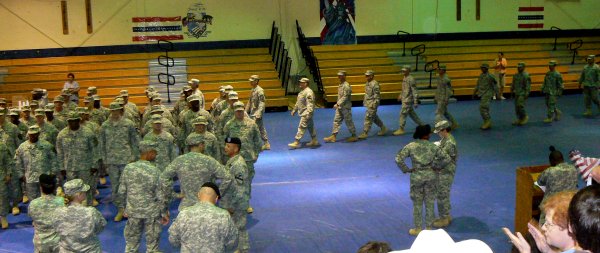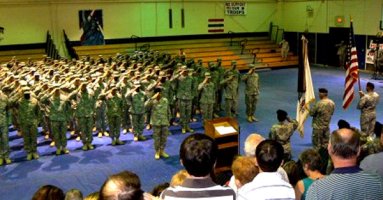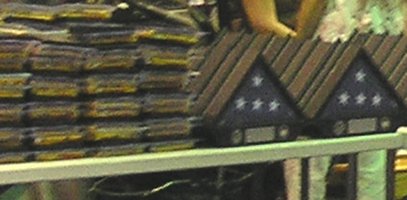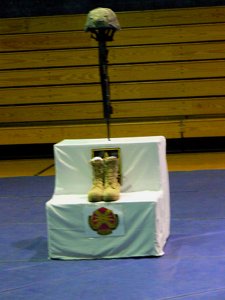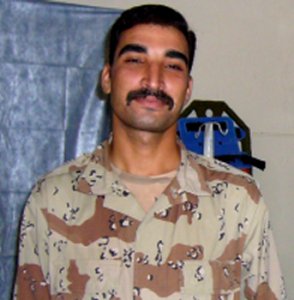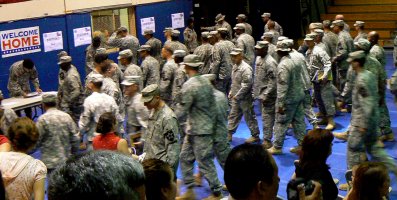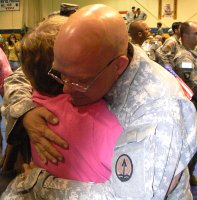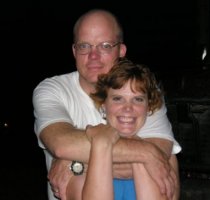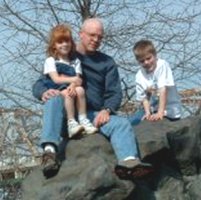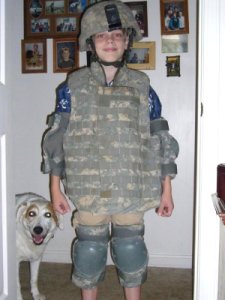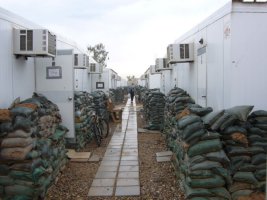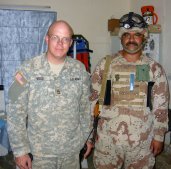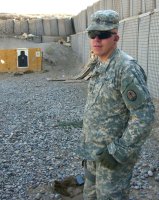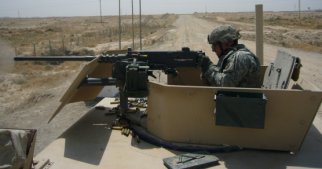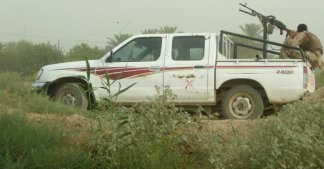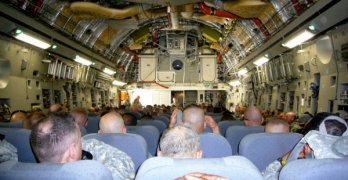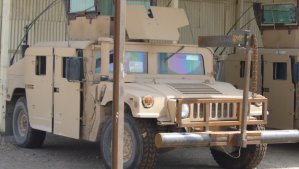On June 12, 2007 at about 3am central time, the 3-3-5 Military Transition Team arrived back at Ft. Hood after one year of service in Iraq in support of an Iraqi Army infantry battalion.
The teams were made up mostly for an Army Reserve group but with about 30% soldiers from the Regular Army, mostly career soldiers. As with all things military, the first activity, once the soldiers had checked in weapons at the armory, was an assembly. As with most things Reserve, that assembly was full of false starts and disorganization, but it did at last happen!
Also like many military events this was drug on and on while senior officers each got a chance to speak and to give recognition to the members of the Reserve, while the soldiers of the Regular Army had to stand in formation, totally ignored. The Reserve general hardly gave notice to the service of those who were real soldiers. In fact, they were so unconcerned about the Regulars that none of their families were ever given any support from the unit command and we even had great difficulty in getting any information about when or where the troops would return! It was discovered that not one member of the Active Army were even on the support list. It was with the help of the staff at Senator Kay Bailey-Hutchinson's office that we were even able to make contact with the proper people. And when we did make contact, it was discovered that no active duty soldier's name was even on the list of returning troops that the command office was using. To determine what flight Ken would be on, I had to give the Captain in public relations the names of some of the Reservists that I knew were part of his team. As happy as we were that our son was returning from Iraq, I remain very angry about the shabby way that all of them were treated. Notice also, among all of the neat gifts for Reservists only is a burial flag for each soldier of the unit? Strange gift for a returning combat veteran.
As is proper at any military return ceremony, just after the playing of the national anthem, recognition was given to those who were lost in action in the year of deployment. Fortunately, for this group there were no members of the teams lost but there were some support personnel. There were some injuries due to hostile actions, among them was one member of Team Buffalo, SFC Rodriguez. Fortunately, "Rod" has now recovered from his wounds. He was returned to the states for recuperation prior to the unit's return and was not present for the ceremony.
At long last the "dismissed" command is given and troops can greet families and start the process of leaving to return home. Since the soldiers came from other parts of the country to join the teams, only a few families were there to greet them. We were fortunate to be able to stay in Texas to greet our soldier but his wife and children were waiting at Ft. Knox for his arrival there. Nearly two more days passed before Ken got to join them again.
Will this be the next soldier that our family waits nervously for his return?
One final footnote. After returning to his command at Ft. Knox our son was awarded the Combat Medic Badge for caring for wounded soldiers, risking his own safety while under enemy fire.
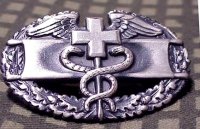
Here are some of the latest pictures that Ken has sent from his station in Iraq. All bold print is quoted from Ken's email.
In early May, Team Buffalo suffered their first casualty, SFC David Rodriquez. Rod, Ken's closest friend in Iraq, was with an Iraqi patrol when he was injured by a "local control" IED. Such devices are controlled by a hidden terrorist with a trigger device and a wire leading to the device. The idea is to wait for the IA soldiers to pass and thus to get the American. Rod suffered a broken leg and some other injuries including to the face from flying gravel and dirt. He was evacuated first to Germany and then to Ft. Sam Houston, where he is recovering. Fortunately, he is expected to fully recover and return to duty, however he will not be returning to Iraq to rejoin the team.
The first shot is one of Ken with the First Sergeant of the IA troops that he works with. Ken is wearing his "blast glasses" which are worn at any time he is outside of the compound. He has another name for them, but this is a public website! As one can easily tell from these pictures, he is very popular with the IA soldiers and officers as well. The third picture shows Ken at work doing emergency field medical training for the troops.
*The second picture* was taken during a mission of myself and two of our interpreters. They happen to be the two I like the best. The team has 5 total, 4 local Iraqis (all from a village about 45 minutes from the base) and one a US contractor from the US. Those two are brothers. I've never pursued it further, but most of the terps learned English in school. I've always been curious if they attended school more than the average, are they a bit more "well-to-do" as if English is taught in school, why more Iraqis don't speak it, plus is that the country as a whole has a 50-60% illiteracy rate. I've always been curious why they all attended school, but the majority of the country didn't.

*Dinner* was taken in the Iraqi mess hall. Usually their meals consist of some kind of boiled meat, this time fish, rice and bread. Yes the red in the back pail is from blood. That is usually reduced and some seasonings added and served as a broth/soup. It's very plain, but not bad tasting, yes I've eaten with them. Of course as you can guess by the picture, you always run the risk of getting sick because of lack of sanitation. Nobody from the team has gotten sick, but there have been times 40 of the IA have gotten sick the same day because of lack of sanitation. This is just the way of the Iraqis, at least outside of the cities. The first picture is from an IA field kitchen. Most of their cooking is done with wood or charcoal and looks more like an army from a century ago.
*Down Town*, *HMMWVs, IA HMMWV *and* US Troops* were all taken during a recent mission, part of the "Clear and Hold" strategy in this area. We ended up building a patrol base overlooking a bridge believed to be a major route for insurgents. It's just different troops kind of contrasting the differences between the US and the IA, plus a look of another village in this area.
The next two pictures are of IA weapons training. Ken reports that such training is a weak area of the Iraqi's. He says that they just don't do much real training and seldom work very hard at it when they do. In the first picture they are training on use of a Russian made, machine gun and in the second on firing an RPG (rocket propelled grenade). The last is a shot of a US F-16 outside of a shelter on a former Iraqi base.
*#1* is a picture taken in the IA Battalion Headquarters of a weapons cache found by the IA. They are very likely to pick them up and bring them back to the base after they find them. The US generally blows them in place, or at least in the area. I will be sending some pictures of a cache being removed from it's location later, I have to get the picture from a buddy. It's kind of interesting, the weapons cache has kind of become the "body count" from Vietnam. It's almost a tool used to "keep score" and judge the success of a mission. The second and third shots are from a wrestling match between a US soldier and an Iraqi. Wrestling is a very common recreation among the Iraqi troops and seems to be almost a national pass-time. Even though the US troops tend to be much better conditioned, it is rare for one to win a wrestling match with the Iraqi's.

*Wrong on many lvls* - This was taken during a recent mission. The title comes from the fact we can play a game of "What's wrong with this picture" with it. The Soldier is a Major on the team (who a few days prior was attempting to convince me of his infantry prowess - he's infantry by branch. If you notice, he doesn't have a weapon, but wait, his M4, with a grenade launcher attached IS in the picture, in the hands of the interpreter, who by policy isn't supposed to be armed (most are though). Guess he missed the training part about not surrendering your weapon. And this my friends and readers, demonstrates just one of the problems that we have when we use so many part-time soldiers in positions of command and the added danger to our professional soldiers when they are put under the command of one.
The last two shots are from a dust storm that took place where they are stationed recently, and the sunset following it. It is a unique part of the world. This may well be the last installment of the combat part of the "Team Buffalo" story, as they now have been told that they will be leaving Iraq for Kuwait and debriefing on June 4, and the target date to fly back to Ft. Hood for processing is June 8.
Next Page
Here are some of the latest pictures that Ken has sent from his station in Iraq. All bold print is quoted from Ken's email.
Tower 10 - This is a photo out of one of the Iraqi guard towers (#10) about 150 meters from our team house. You can't really tell in that picture, but you are about 30 feet off the ground.
Along the Wall - Also taken from that guard tower, just looking along the wall of the base in either direction.
Dali Abas - This is a photo of the Iraqi Army compound in Dali Abas. The Battalion has one company stationed there and it's about 30 minutes from the base. The armored vehicle you see is a former American vehicle (repaired after scavenged from the bone yard) that the Iraqis used on missions. It was hit by an IED and had the left front drive sprocket and road wheel blown off. A funny thing about those vehicles, the Iraqis feel safer from IED blasts in them, but because of advancements in metallurgy (they where made in the 60's) the thinner armor of the HMMV is actually better. but they make them feel safer and sometimes that's what matters.
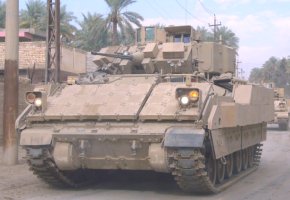

- This picture of a Bradley Fighting Vehicle was taken during the most recent large mission. The current unit here, 6-9 Cavalry, 1st
Cavalry Division, is using the Bradleys far more than the previous two units, I'm unsure why, other than they are much safer in an IED blast.
Iraqis on mission - nothing special, just some of the Iraqi Army during that mission.
A very dangerous place to be!
The last of the pictures are in sequence and show bit of the threat and what EOD does here. On that mission we located about 10-15 IEDs and several caches. The majority of the IEDs where driven past by some, or the majority of the vehicles, but for whatever reason were not detonated by "the bad guys" One of them, that was found as troops started searching the buildings around our immediate area was about 60 meters behind where I was parked, so I ended up with front row seats of what happens next. Well, front row, looking through bulletproof glass and through a rear view mirror.
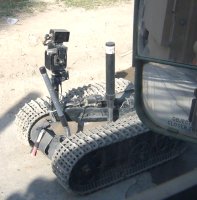



Robot and robot up close are pictures of one of the robots EOD uses to examine explosives from a safe distance and carry charges down to blow them up.
Driving the robot - this is the EOD tech (Air Force, that's why the different uniform, but there's also both Marine and Army EOD) driving the robot by remote control. MAJ D, one of the team, is watching over his shoulder. (click on the picture to see the Major)
The rest of the photos where taken through the side mirror or out the turret by the gunner.
Going to look 1 and 2(click on picture to see 2) and looking are the robot on it's way down to take a look at the IED and to place the charge to blow it up. In the first two, the yellow can you see is sitting right beside it. The can was placed there by the troops that found it as an easy way of identifying where it was. In Going to look you can see a green wire on the ground on the side of the mirror. That's the wire connecting the explosive charge to the detonator used to blow it up.
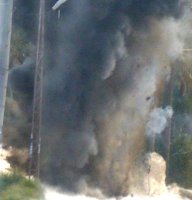



BOOM - 1 pound of C-4 plastic explosive and a 155 mm artillery shell make quite an explosion.
After blowing up the round, EOD drove the robot down to look again and verify that the round was destroyed. Well two things happened, first, there was another 155 mm round in the hole. The first charge on blew the top round, and the IED was composed of two rounds. Second, the driver got too close to the hole and the robot toppled over into the hole, with the IED in it. Well, EOD had to drive down and rescue their robot and that's what the last pictures are of. Remember, there is still a live 155 mm artillery round in that hole, under the robot. After rescuing the robot, they place another pound of C-4 on it, with a timed fuse.
So now you know what the #1 threat to our troops is while serving in Iraq. And the guy who helped out the robot? Now there is a man with guts! Unfortunately, I do not know his name to give him credit for what he does.
And this was the result of an Iraqi armored Land Rover that hit an IED.
The driver was killed and one other occupant died 2 days later. He was made worse (head injury) because of the Iraqi attitude about wearing helmets. He probably didn't have it one (or the chin strap snapped anyway). There was another casualty that didn't either. The other 4 people in the vehicle where sent to the American Combat Support Hospital.
In the first picture Ken is treating an Iraqi soldier who has been injured, and instructing the Iraqi medical personnel. In the next we see two of the members of Team Buffalo in a period of just "goofing off" while on base in a secure area. The last picture shows that even our troops need a break for Christmas.
Next Page
This map shows where Team Buffalo is stationed. It is a base that is for the Iraqi Army with one the US Army battalion. To the right of their location is the border with Iran.
"Republican Guard Logo painted on one of the hatches of the vehicles in the bone yard here. It's kind of curious that the vehicle is there, as most of the equipment is captured Iranian equipment from the Iran Iraq war. There is some old American equipment there, provided to the Shah when he was in power."
The second picture is of the US Army aid station on the base, to contrast with that posted earlier of the one for the Iraqi army. In the third picture is the latest in HMMV equipment.
"HMMV upgrade - this is my vehicle. Amazingly we were two of the first ten vehicles in the country to get the latest and greatest armor upgrades for the HMMV. The side armor, the majority of the threat direction is about twice as thick as before. Of course it comes at a cost, the doors now weigh about 500 pounds each and it further overloaded the vehicle. As loaded when rolling on missions it now weighs over 15,000 pounds, the maximum gross vehicle rating for the HMMV is 12,200 lbs."
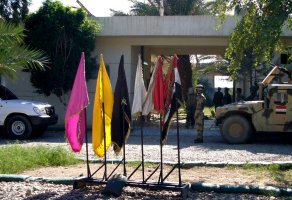
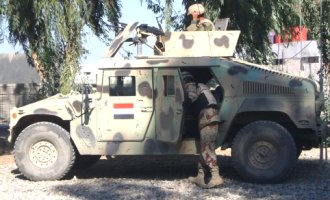
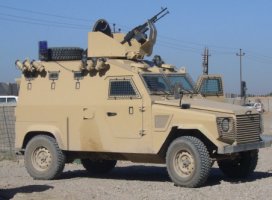
"I took this picture of the Iraqi Headquarters building. The flags represent the five companies in the Battalion."
"This is an Iraqi Army HMMV. Yes, it's the same as the American, either provided by us, or possibly bought by the Iraqi government, right off the factory floor. The battalion has 14 of them. The camouflage pattern is the same as the original American Dessert cammo pattern, seen mostly during Dessert Storm. We never painted our vehicles that way though, just sand."
"IA Land Rover - These are the other armored vehicles the Iraqis have. They are made under license in Turkey. According to the book, the armor
will stop a 7.62 mm bullet (.30 caliber), but since they are significantly lighter than our doors, I wouldn't want to test it."
"LSAA Housing - During my most recent trip to Logistic Support Area Anaconda (I believe the largest base in Iraq) I took this picture of how
"the other half" lives. These are the trailers that house the majority of Soldiers in Iraq. Each room is for two Soldiers, I'm not sure exactly how big the rooms are. The sand bags are incase of a mortar attack, it gives something for people inside to hide behind. Rarely do mortar rounds come in that we (the American Forces) don't know at least a few seconds before impact - the advantages of ground surveillance radar. We also attempt to shoot back. In a couple of places at Anaconda there are Phalanx gun systems - look to be the same as on naval ships. I'm guessing to shoot the mortar rounds down, since it was designed to shoot down missiles before they impact ships."
I want to add one additional thought of my own to this new page. If you want to know a lot more about what Ken and Team Buffalo are dealing with, and what seems to me to present a pretty accurate picture of what is happening there, see if you can locate a copy of the Oct. 18 issue of the "Wall Street Journal." In an article written by Greg Jaffe there are a number of quotes from members of the team which this team replaced at the duty station where Team Buffalo now serve. The story is titled "Problems Afflict US Army Program To Advise Iraqis." The newest team to arrive on the base where Ken is stationed is made up of "Regular Army" so it does seem that things are changing, or at least beginning to. Team Buffalo was one of the last teams to be trained prior to the First Infantry Division taking responsibility for this transition program and the training was moved from Ft. Hood to Ft. Riley.
Next Page
The latest update from Iraq is about the duties of the medical team and the mission that they do. In the first picture, Ken is posed with the platoon sergeant in the battalion aid station where they care for the troops.
"A funny thing about the Iraqi’s they like having their pictures taken. They will then ask you for copies of the pictures, though. I guess cameras and photo developing are very expensive here so not a lot of people have cameras."
In the second picture you can see that their aid station is kept very clean and in good order. But you might also notice that there is no bed, just two stretchers there. The sergeant asked Ken to get them a bed and Ken suggested he go through the Iraqi supply system.
"The bed request died after I suggested he order through his chain of command."
"Most Iraqi's don't want to expend any effort in solving any issues. They want someone else to do it for them. A good example is the platoon sergeant for the medics told me awhile back that he wanted a bed to put in the aid station. I replied, okay, have you asked for a bed from his unit? No, of course not, that would have required effort and possibly rejection on his part. Much simpler just to have me do it."
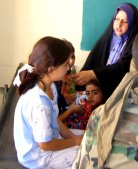
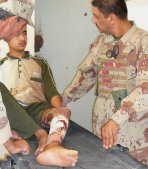
"We also participated in a MEDCAP (don’t know what it stands for but it’s when you go treat civilians. It was a joint mission with both the Iraqi Army medics and the Americans."
In the first picture you can see the typical equipment worn by all American troops. This happens to be the mission commander, but all soldiers wear pretty much the same type of gear. The pouches are ammunition. Even the medical staff today go into the field armed. Also you can see the body armor that is worn by all American soldiers. These pictures also show that the Iraqi troops are not nearly as well equipped. In the third picture an American doctor is treating a civilian with a broken arm, assisted by the Iraqi medical officer. The Iraqi battalion has no doctor but two medical officers who are both nurses. The one in this picture is Lt. Walid. In the last picture a burn victim is treated by two Iraqi medics.
The shot here is another of the doctor and the Iraqi medical officer. Any visitors who are familiar with middle eastern geography will have heard of the Tigris River, which is the on it the two river shots. It seems a little surprising to see one that large in the desert. Ken doesn't know, but believes the bridge to have been built by the Americans. He did say that there was no sign of rubble to indicate that there was ever one there before this one.
The last picture is of an Iraqi cemetery. This one is typical of what you see in this part of Iraq. All seem to be some type of above ground crypt and he has seen no sign of any decoration of the graves, as you would see here. The people in the cemetery seem to just be passing by.
Next Page
Sept. 10 through October 1, 2006
For any reader who may know someone stationed in Iraq, here is a need that could apply to any member of any branch who is stationed with a field unit of any type.
"One request I do have, specifically for you because you are COSTCO members, is for bulk powdered Gatorade, preferably in packets. They do make packets that are designed to be mixed into 1 quart of water. Our water comes in 1 liter bottles - close enough. I know this might be/get expensive so the team will pass the hat to offset any cost. The mess hall stocks the bottled variety and it just isn't conducive to carrying on missions. Other powders to mix into the water also would go over well. When it's 120 degrees, in full battle rattle (about 70 pounds including body armor) you drink a lot of water and get sick of it. Especially when the water is piss warm. You can only carry so much ice in the humvees. Plus Gatorade also helps replace the minerals lost through sweating."
"We work mostly with the officers, but do work with all soldiers for some things. While the IA has the ranks of NCO's, they don't have an NCO corps in any way near the American sense." (Actually, very few countries have an NCO corps like the US military does.) "How can you expect the NCO's to do their job when one of their fears is that if the upset the officers badly enough, they will get an immediate demotion back to basic Soldier? That fear was expressed by the Battalion Sergeant Major. Literally, they have Captains doing work that would be the job of a Buck Sergeant in our army."
"Most Iraqi's don't want to expend any effort in solving issues. They want someone else (of higher position) to do it for them. A good example is the platoon sergeant for the medics told me awhile back that he wanted a bed to put in the aid station. I replied, okay, have you asked for a bed from his unit? No, of course not, that would have required effort and possibly rejection on his part. Much simpler just to have me do it. You also get sick of the IA telling you that this or that system isn't working, (agreed it probably is horribly broke - like any kind of re-supply) but when you ask them what they have done to help the situation, or work on the problem, you get either the "deer-in-the-headlights" look, or the ever popular shoulder shrug while saying "Im sha Allah" which is "god willing". " Ken states that "god willing" is a common way to avoid work, or more importantly responsibility in Iraqi society.
"Most of the more senior ranks are from the old Iraqi Army and quite a few fought in the Iran-Iraq war, both gulf wars, misc. fights with Kurds, etc. Plus the unit saw some major action a few months prior to us getting here, and no matter what the mission is, IED's go off and small arms fire is a regular occurrence on missions (both IA and American)."
This is where Team Striker lives. Notice the wire that is circled in the picture, and note that it is inside of the compound. "I've also sent a picture of our team house. We have been adding the concertina wire around it to improve our security since our house sits about 100 meters from the edge of the base. The green vehicles are "Waz's". Basically Russian jeeps. "
In the second picture, note the ejected shell casing that is just above the gun barrel. In Iraq, even medics carry weapons and practice with them. "We were practicing some of the close quarters combat techniques we've been learning from the local Special Forces Team. As you see, it's short range - that's the 10 meter line. But that's were most of the combat here has been taking place. It's also more about speed than the normal for Army ranges. We have been doing most of our shooting without all of the Army stuff - helmet and such. The method is get the muscles used to doing it the same way every time and then it won't matter what you are wearing. Of course muscle memory is all about the number of rounds fired. I've said for a long time that the average Soldier doesn't fire enough rounds. Most of them only fire about 100 rounds a year - 40 rounds qualification and 16 rounds to confirm zero twice a year. I've probably fired around 1000 rounds since I've been here."
"In the time I've been here, I've fired more rounds than in the previous 19 years. Shooting is also a good stress relief. I doubt this is something the majority our Soldiers here are doing, but hey, there are some advantages to doing this mission."
"The Iraqi Battalion Commander came with us. He's the new one as the last one was killed in a car bomb."
Next Page
"To truly experience the "anti-road rage" you also need the signs the American forces use. They basically say "American Convoy - Stay back 100 meters Deadly force is authorized" and yes it is authorized and used. The saying here as far as vehicle travel are "Drive like you stole it" and "We Own the road" Of course that's also why the insurgents use IEDs. "An M1114, Armored High Mobility, Multi-purpose Vehicle (Hummer or Humvee to you) should do the trick. 14,000 pounds of armor, 7.2 liter supercharged engine, with a gunners cupola for a .50 caliber machine gun should do the trick. Comes standard with heating and Air conditioning. Of course for the low price of $145,000 you would think it would come with a CD player (lol). That price doesn't include the three radios that are in it, nor any other hardware and there's a bunch) Think of that stuff as "dealer added accessories"
"First thing for me about the Iraqi Army is they have my admiration. People say the American military is an all volunteer force, but it isn't compared to the Iraqis. Not only do they all volunteer to serve, but they can quit at any time. They get frustrated, tired, sick of it, etc, they can walk away and no longer be in the army. Of course this also leads to issues of it's self because you never truly have accountability of the troops, nor strength. They work 21 days straight followed by 7 days of leave (Jaza) Until the soldiers coming back are back, you don't know if they are coming back. A significant number wear masks when they leave the bases (as do most interpreters) because they don't want to be identified by terrorists/insurgents to protect their family. Imagine me having to hide the fact that I'm in the Army and wearing a mask when in uniform to keep Mindy and the kids safe from attack. Granted most of them would be herding sheep if they weren't in the Army, and it's the only steady work they can get, but still......"
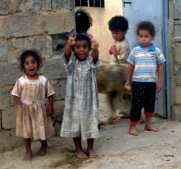
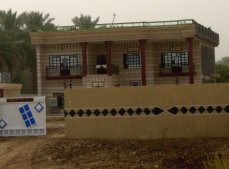
"I wanted a good picture of what the "average" Iraqi lived like. You can't quite see it, but in the back right of the house is where the donkey stays. Yes, that's all dirt, except the grass patch in the middle. Fine mud brick construction with tree branches and rebar holding the mud brick roof up. You also should notice the bedding on the grass and the reed beds. When it's 90 as a night time low, and no AC or air movement, you sleep out side, with the chickens. " The house to the right is a wealthy family.
"Most of these pictures were taken while out on patrols with the Iraqi Army. There might be a bit of fuzziness to them because they were taken out the window (no we don't open the bullet proof windows) of a humvee and there is dust everywhere here, including the window I took the pictures through."
"The Iraqi village in the picture is the one being searched. Notice the mud walls. Most of the houses are built from mud bricks dried in the sun and then have a layer of mud put over them. Also notice the white circles on the rooftops. Those are satellite dishes. In Soldiers the guy in dessert uniform without a helmet is an interpreter. The sign on the back of the humvee says, "Stay back 100 meters. Deadly force is authorized." in Arabic. Because of this (and we drive in the middle of the roads) driving here is like the parting of the sea. Iraqis move to the side of the road as American convoys approach and do not come near. Incase your curious, the shorter thick antennas you see on the backs of the humvees are part of the electronic warfare (jamming) units vehicles carry."
A few questions, and their answers.
How good is the Iraq Army? "That's a tough one to give a qualified answer. By American standards? They suck. By Arab standards? Pretty good. "
Will they ever win over their own population? "Probably. Most Iraqi's feel that the security forces (army and police) are mostly doing a good job, in this area anyway. It's like anything, the key is basic services water and electricity."
Do you ever get a chance to make any contact with anyone who is not a part of the Iraq Army? "Very limited."
Are there more citizens who support the current government, or are they a minority? "I do believe that most do. It's believed that the majority of the insurgents (other than former Baathists) are foreign."
What is the weather like over there? "Hotter than hell. About what you would expect. Most days the highs are between 110 and 120. At night it drops to the low 90s. No rain for the last four months and none forecasted till Nov/Dec. It has changed my perception of what "hot" is. Now, at 90, I'm saying, hey, this is nice. Another change that's occurred, back in May, when we got all of our wonder gear, everyone was commenting on how heavy the body armor was (it weighs about 45 pounds). Now it's not heavy, it's just HOT!"
"This country really should have a lot going for it. This part of it would be beautiful. This is the origins of civilization and talk about biblical history. It's believed that Abraham lived in the town of Ur, in Iraq. It's also rich in other minerals than oil, assuming the country can pull it's head out of it's ass.
Most of the countryside the towns are straight out of the 1800s. If you where to take a photo, photoshop out the power lines, satellite dishes, and internal combustion engines, you would not know when the picture was taken. Most of the villages are constructed out of mud bricks and mud.
The Arab mind truly is different and you have to understand that when dealing with them. A good example is how they identify themselves. Most Americans Identify themselves as Americans first. Not here. Here it's self, family, tribe, clan, then country, and to most religion has to fit in there too, before country. Of course some tribe/clan rivalries have been going on for 1000's of years. Another example is the concept of honor and "face". A lie isn't a lie in our sense, if it's to protect your honor. Of course not knowing something is also dishonorable, so generally if you ask a question (say directions) you will get an answer. Might not be true (he might not know), but you will get an answer. This job has been referred to as being a cat harder because of trying to work within the Iraqi system.
Something else I've learned since coming here is the Sunni/Shia rivalry hasn't always been what most Americans are lead to believe. Forty years ago it wasn't much of an issue, but it was encouraged after Iran became a religious state to help keep the Ba'ath party (mostly Sunni) in power because in all of the Arab/Muslim world only Iran and Iraq have a Shia majority. The government feared an Iranian influence. If groups are busy at each others throats, can they worry about the tyrants at the top? 80% of the Muslims of the world are Sunni."
For any reader who may know someone stationed in Iraq, here is a need that could apply to any member of any branch who is stationed with a field unit of any type.
"One request I do have, specifically for you because you are COSTCO members, is for bulk powdered Gatorade, preferably in packets. They do make packets that are designed to be mixed into 1 quart of water. Our water comes in 1 liter bottles - close enough. I know this might be/get expensive so the team will pass the hat to offset any cost. The mess hall stocks the bottled variety and it just isn't conducive to carrying on missions. Other powders to mix into the water also would go over well. When it's 120 degrees, in full battle rattle (about 70 pounds including body armor) you drink a lot of water and get sick of it. Especially when the water is piss warm. You can only carry so much ice in the humvees. Plus Gatorade also helps replace the minerals lost through sweating."
Theses women are dressed in the most common way in this part of Iraq. Keep in mind that typical temperatures are 110+ degrees and modern plumbing does not exist in most villages. "For the men, imagine the Body Odor after wearing it all day in that temp. Not that it truly matters because women are for having babies and men (and boys) are for fun. It's joked as "Man-Love Thursdays"! It's also curious that I've yet to see a face covering." (August 22, 2006)
Next Page
This story begins with SFC Wood reporting for pre-deployment training at Ft. Hood, Texas on May 1, 2006. From here on, what is in bold print is quoted from the notes that I have received from Ken in Iraq. (bold print items are quotes from Ken)

Having visited Ft. Hood, I'm not sure that I would name it "The Great Place," but that is what the command has declared it to be. Ken was assigned duty with a transition team. Transition teams are the people most involved with the "exit strategy" from Iraq, that our press and some politicos love to tell everyone does not exist. There is at present a major effort to improve the Iraq Army and to turn over more responsibility to them..
Six weeks were spent at Ft. Hood in organizing into teams and becoming combat ready, if you ever can be. The following is a direct quote from an email sent from Ft. Hood, before departure for the middle east.
"The biggest shock as far as training was while at Fort Hood - the amount of time off. I do believe at least 1 week could have been cut out. A lot of the training has focused on some of the newer communications systems and other systems designed to keep Soldiers alive. The amount of equipment fielded designed specifically to counter IED (the #1 threat to Soldiers) is staggering. It's actually where a lot of the complaints since this war started have come from. But people don't seem to understand the government can't snap it's fingers and make things appear, they still have to be manufactured by somebody. The support of the troops when it comes to quality of life is also staggering. Of course, Soldiers still bitch, but they always have and always will continue to do so."
Next, destination Kuwait! They arrived on May 20 at 2am and the temperature was 113 degrees. This is an important date because it is the day that the count begins for the 1 year of deployment "in theater."
"95% of the training is the same for everyone. ....... The overall command and structure of this group came from a reserve training division - with a mission of conducting army training (basic, MOS, etc). ....... "
The ranks, when viewed L to R are front row - Ken (SFC, SSG, MSG back - CPT, SSG, CPT, MAJ, 1LT (soon CPT),MAJ, and SSG.
"I should know more about the Iraqi living conditions once I actually start doing my job. But one thing I can tell you is satellite dishes and cell phones (both not allowed under Saddam) are everywhere."
July 1, one more stop in Iraq for final training before beginning the actual work that these soldiers were ordered here to do.
This is Taji, Iraq the former home of Saddam's Republican Guard. It is the most luxurious of any Iraq Army facility and far beyond what most local citizens ever have access to. Notice the "modern" toilet. The user just squats over the opening and does their thing. It is all ceramic tile and thus easy to keep clean. Notice also that there is no toilet paper holder! That is because the plumbing will not deal with paper. But if you look to your left on the wall you can see a nice chromed faucet. It is there so that once you have completed what you came for, the final task is done with your left hand, which you then use the faucet to wash. No paper is needed with such a toilet.
"We will be advising the 3rd Battalion, 3rd Brigade, 5th Iraqi Infantry Division. "
"To answer about living conditions, it's hard to categorize. The US troops live in everything from very nice to bad. Of course it's also been my experience that those that bitch the loudest are also those that have it the nicest. Go figure. When you are at the bottom, any improvement is a good thing, and you don't complain."
On July 11, 2006 the team arrives at there assignment and begin their mission, supporting and training an Iraqi Infantry Battalion.


